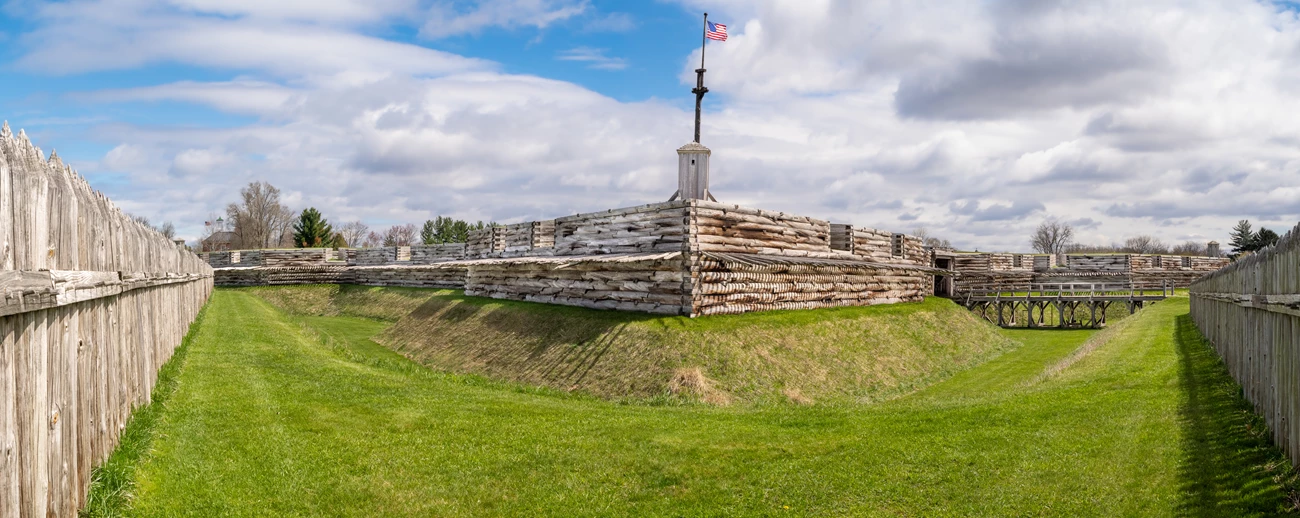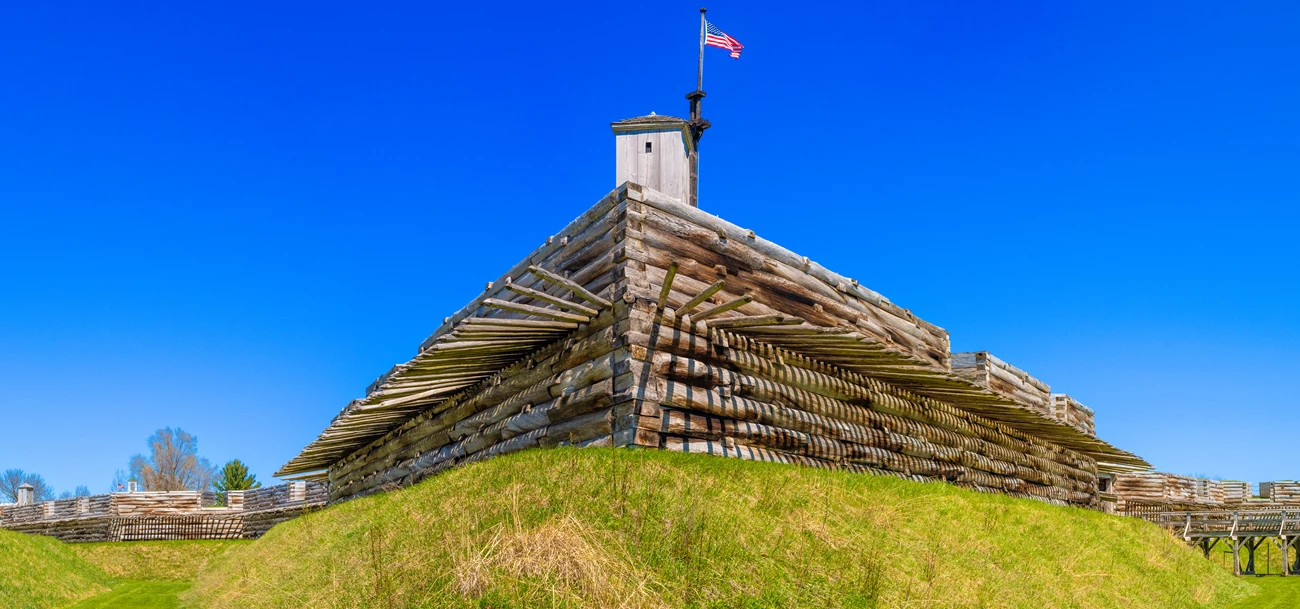|
If you cannot find the information you are looking for on the page below, please feel free to contact the park. 
National Park Service/Dan U. Frequently Asked Plan Your Visit Questions Please visit the Directions page for more details.
The cost is free for both the visitor center and fort exhibits.
If you plan on participating in a permitted activity on park grounds, you may have to pay a fee or apply for a permit before your arrival. Some activities include large rallies and gatherings, photo and video opportunities for profit, weddings, etc. Please look through the National Park Service Permit Applications and Guidelines or call the park at (315) 338-7730 for more information.
Park hours vary throughout the year. The fort grounds are normally closed between late December and early April. Hours for the grounds in others seasons vary. Please visit the park Operation Hours & Seasons page for the most up to date information.
It generally takes 30-45 minutes to explore the park visitor center and 30-60 minutes to explore the historic fort. However, there are many monuments, museums, and trails adjacent to park trails that are also worth the visit. Visit the Things to Do page or ask a park ranger for recommendations.
It is highly recommeded that visitors download the National Park Service app and take advantage of the many self-guided and walking tours available on it. There is also a park cell phone tour that can be accessed by dialing 1-315-271-2059. Low/No Vision
No.
National Parks and Federal Recreation Lands Pass and the Senior Parks Pass are not offered at this site as there is no cost to enter Fort Stanwix National Monument and you do not need a pass to enter the park. You can however, acquire the Every Kid Outdoors (4th grade), Military & Veteran, or Access Passes at Fort Stanwix National Monument whenever the visitor center is open. You can find all that information on the following link to the For Teachers page. All educational field trips are free unless otherwise noted.
You can find all that information on the following link to the Group Tours page. All programs are free unless otherwise noted. The park offers numerous different opportunities for service work for individual scouts, as well as entire troops, and other youth groups. Educational field trips can be booked by any troop or council leader for groups ages 5+.
All educational field trips are free unless otherwise noted. To review all options please look through the following Girl Scout and Scouts BSA park pages. Fort Stanwix provides a Junior Ranger Activity Booklet free of charge to children of ALL ages. You could also choose to try the program from home if you are unable to visit the park. Just visit the Fort Stanwix Junior Ranger page for more information about how to participate!
Pets are allowed inside the fort proper as long as they are leashed and under control. They are not however, allowed in any of the enclosed buildings. Please be aware that some areas are much different than your pet may be used to and it is important to watch their reactions for their and all visitors' safety. ALL SERVICE ANIMALS ARE PERMITTED. Please click this link for more animal/pet information. The park provides no concessionaires, but people are welcome to bring their meals to picnic on the park lawn or at the picnic tables outside the visitor center. There are also numerous eateries in Rome on all the main routes into the city. They vary from fast food, to bistros, to sit down restaurants, local and chain. Many are a few blocks walking distance from the park on different side streets.
Please visit the Rome, NY Chamber of Commerce webpage, for complete listings of what is available. There are several hotels, motels, and other inns that are available to stay at within a 20 mile radius. Please visit the Rome, NY Chamber of Commerce webpage, for complete listings of what is available.
There are no camp facilities at the park. However there are several facilities within an hours distance or less, both private and state run.
Please visit the Rome NY Chamber of Commerce webpage and the New York State Parks webpage for complete listings. There are no overnight facilities for the visiting public at the park. Overnights do occur, however, on specific occasion. If you are planning a special event and would like to obtain a Special Use Permit, please call the park at 315-338-7730. Or, if you are part of a living history, scouting, or 4-H group wanting to participate in one of Fort Stanwix's Special Events, please contact the park VIP Coordinator for more information.
Frequently Asked History Questions August 21, 1935 when the Wagner-Sisson (Fort Stanwix) Act was signed by President Franklin D. Roosevelt.
However, it remained largely unrecognized until the late 1960s when a local push was made to make it more noticed on a national scale in preparation for the nation's 200th birthday. A "national monument" is intended to preserve at least one nationally significant resource. Fort Stanwix became a National Monument in 1935 because of its significance through the French and Indian War, through the American Revolution, and as a gathering place for treaty signings with American Indians.
Fort Stanwix was the fort's name under the British; for Gen. John Stanwix. When the Americans rebuilt it they named it after Gen. Phillip Schuyler. However, there were several other Fort Schuylers in New York at that time, so the name never really stuck due to the confusion.
To protect the Oneida Carrying Place, a trail 6 miles long between the Mohawk River and Wood Creek. This is part of the larger New York water way system, the only natural break in the Appalachian Mountain chain.
Tories were an 18th century political party that remained loyal to the British Crown throughout the American revolution, loyalist is common language for any American British subjects that remained loyal to the British. Rebels and patriots, likewise, are common terms for American British subjects who joined the fight against the Crown. The French and Indian (or Seven Years War) from 1758-1763, and American Revolutionary War, from 1776-1781. In other portions of the world, including Canada, this war is known as the Seven Years War.
Generally, the British and Six Nations Confederacy Tribes in the 13 Colonies fought against the French and Great Lakes Natives from Canada.
The Six Nations Confederacy, or Haudenosaunee Tribes, are the Mohawk, Oneida, Onondaga, Cayuga, and Seneca make up the original Five Nations. In 1714 the Tuscarora were admitted on Oneida land as a sixth.
"Iroquois" is the French term for the Six Nations. "Haudenosaunee" is the term they use in their own language. It means "People of the Long House."
Since the French were never direct allies with them, and they are most directly referred to in British and American accounts as the "Six/Five Nations" (referring to the number of tribes in the confederacy), it is most appropriate to call them by one of those two terms and not "Iroquois." The Boundary Line Treaty of 1768 and the Treaty of 1784 were the two major ones; several others followed.
The Six Nations split into many factions based on whether they thought the British or Americans would best support their interests after the war. More can be learned by visiting the park History & Culture pages.
It is not certain which flag flew over Fort Stanwix during the Siege of 1777. All that is known is from several accounts: it was made of blue, white, and red stripes, and it was flown "on behalf of These United States" and in defiance of the British, by the officers and soldiers inside the fort.

National Park Service/Dan U. |
Last updated: December 7, 2023
